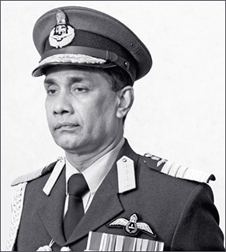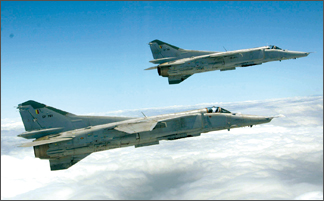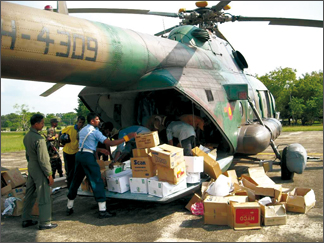|
The SLAF Team - a journey revisited from Mavil Aru to
Puthumathalan:
The eyes, the ears and the power from the skies
|

Air Chief Marshall Roshan Goonetileke
|

Air Force attack aircraft in action |

Air Force on a mercy mission - ferrying food for IDPs |
Never before in its history has the SLAF been tested to its limits of
performance, and strengths and never before has it performed with so
much vigour and commitment and achieved this amount of success. The
journey from Mavil Aru to Pudumathalan for the SLAF was long and arduous
but fulfilling, and the team kept the ensign flying at dizzying heights.
At the commencement of the humanitarian operations, the first to go
in were the trusted work horses of the No 06 Squadron (Sqn) - the MI 17,
transport helicopters. Ferrying troops and equipment into battle, and
replenishing them. The tested and faithful Bell 212’s of No 07 flying
out of A’pura and Vauniya were always at hand, evacuating casualties and
carrying them to hospitals.
Air support
The Mig 27’s of 12 Sqn, the Kfirs of 10 and the F 7’s of No 05
followed soon, providing close air support to the advancing troops.
Pressed in to service at short notice, but brimming with skill, courage
and determination the men and their machines blasted passages for their
brethren on the ground to forge forward.
The MI 24’s, of the No 9 Sqn followed next, flying low out of the
horizon, disgorging their deadly arsenal of 80mm rockets with uncanny
precision, whilst strafing the illusive enemy out of his strong points
with their deadly 23 mm ‘Pushkai’, 30mm ‘Gash’ and 12.7 mm ‘Gatling’
guns.
Rarely spoken of, the ‘lords of loads’, the No 2 Sqn, with its An
32-B’s and the giant C130 Hercules, carried troops, and cargo round the
clock.
The men flying the UAV’s from ground stations pushed both the
machines and themselves, up to safety limits to ensure real time imagery
was available, through out These men who flew the ‘Eyes and Ears’ in the
sky, burnt hours of midnight, oil, and rubbed their bleary eyes to peer
into screens, to catch the enemy’s moves on the ground.
Clouds of secrecy
The pilots and crew of the Beachcraft (King 200) veiled in the clouds
of secrecy, as thick as the clouds in the high skies they fly in, flew
and worked tirelessly to relay information to the decision makers on the
ground.
As the nation was deep in slumber those men cooped up in the confines
of the Beachcraft depended on coffee and sandwiches for sustenance
whilst flying sorties lasting more than six hours each at heights above
twenty thousand feet.
Their story too may never be told, like the many meals they missed.
The technicians and ground crew focused their untiring energy to
achieve, things beyond reality. Battle damages or unserviceability did
not effect efficiency, aircraft were promptly returned to the flight
lines after repairs in record time. Innovation and ingenuity of these
crews kept the aircraft in readiness throughout.
The SLAF team “had begun ticking and soon, the ‘team’ led by a
seasoned campaigner, supported by a dedicated ‘core’ was clicking to
harmonious perfection.
The SLAF role thus far defined needed to be reviewed with the entry
of the LTTE’s light fixed wing aircraft into the fray. An Air Defence
Network comprising surveillance radars, interceptor aircraft, surface to
air missiles and air defence guns was established to meet the new
threat.
Established at short notice, challenged immediately the network of
radars, interceptors, surface to air missiles and anti aircraft guns,
patiently honed its skills. The first taste of success was when an F-7
interceptor of the 05 Sqn intercepted and destroyed an LTTE Zlin 143
over Mulaitivu. Finally the gunners of No 32 Land Based Air Defence Wing
shot down the two LTTE flying bombs before they carried out their design
of carnage.
Humanitarian operations
The humanitarian operations, by now had extended beyond the banks of
the Mawil Aru, Sampoor, Wakarei and the jungles of the Thoppigala had
been liberated. The advance now was on multiple fronts and in more than
one theatre.
The SLAFs’ resources needed to be deployed thriftily to support these
multiple fronted advances. Subsequent to the Mavil Aru expedition the
SLAF commenced the systematic destruction of the LTTE’s war fighting
capability, through forays by Mig 27, Kfirs, and F 7s’, far behind the
frontlines (interdiction missions).
Training camps, supply dumps, boat building yards, munitions dumps,
and concealed Sea Tiger vessels faced the brunt of these attacks.
Precision strikes, literally surgical, ensured that training during day
came to a stand still, thus resulting in reinforcements to the Tiger
frontlines being severely effected. Logistics and other infrastructural
activity were engaged, swiftly.
SLAF juggernaut
The leadership already plagued by the elite LRRP’s, on ground found
themselves now threatened from the sky. The Tigers found to their
dismay, that their attempt to derail the SLAF juggernaut by the attack
on the A’Pura Air Base had dismally failed when the Kfir’s of No 10, and
Mig 27’s of No 12 took out Thamil Chelvem, the defacto political wing
leader, and followed it up with many strikes deep in the belly of the
tiger areas. Meanwhile, the ‘Braves’ of the No. 9 Sqn, flying their Mi24
Hind’s constantly zeroed in on points resisting the advances of the
three fighting Divisions and the Task Forces.
The men of these Divisions speak with pride and appreciation, of the
‘close air support’ provided by this form of airborne armour, in their
time of need, when resistance was fierce and advance was stalled. The
dangers faced and experienced throughout this campaign, by the men in
the ‘Hinds’ may never be told and may remain on a dusty shelves holding
classified documents forever.
Flying the MI 24 on night operations is a manoeuvre not attempted by
many Air Forces flying MI-24’s. Among the many distinctions the men of
this hold is the fact that they perfected the art of night operations
with the ‘Hind’. Thus close air support was provided continuously,
during day and night even in unfavourable weather.
In the melee, the SLAF Regiment, the infantry element of the SLAF was
called upon to hold vast areas of the land of the Western Wanni and
around Trincomalee to relive the Armies’ infantryman from the holding
role to join the fighting Divisions.
SLAF Special Forces
This required vast quantities of resources in men and material to be
released. The Regimental Special Forces or the SLAF Special Forces
element too became operational during this period.
The Mig 27’s were flying sorties continuously, revealing in the roles
of interdiction, and close air support. These stout, swept wing birds of
prey, had now been mastered to perfection by the pilots of 12 Sqn. They
developed their own tactics and manoeuvres, and hold the proud
distinction of being the only ones of the many users of Mig27s’ to fly
night operations.
“Bad buy”
Blamed as a bad ‘buy’ at one time these machines which carried the
biggest payload will be remembered for its shrill engine sound when
flying in low, to pound the enemy positions, and the destructive power
that followed. Flying low at supersonic speeds the threats and dangers
these men faced might never be revealed.
The Kfirs, though aging were up to the task, surgical precision being
their forte. The pilots of the 10 Sqn hold the unequalled distinction of
knocking out the most number of LTTE Artillery pieces and Sea Tiger
attack boats.
The Israeli built ‘Lion Cub’ has now served the nation through
thirteen years. The men who mastered the machines will be remembered
forever for those precision strikes that broke the spinal cord of the
enemy.
The F-7 Chinese built interceptors first came into service in 1992,
and now are mostly used in their dedicated role. The 5 Sqn which flies
these supersonic predators holds the unique distinction of having scored
the first and only air to air kill, over Sri Lankan soil, after World
War two when it shot down an LTTE Zlin 143 aircraft over Mulativu.
They will constantly stand vigil with its surface to surface
capability to intercept and destroy any intruders in our air space.
The SLAF flying formations, attack, transport and surveillance
contributed their mite from Mavil Aru to Puthumathalan. The SLAF
Regiment contributed in no small measure ensuring the security of the
air bases, and taking over the responsibility of securing land liberated
by Army Divisions.
The SLAF organization as a whole, Engineering, Logistics,
Administration, Civil Engineering, and Medical contributed to keep the
machine working.
Though never heard by the outside world, their role was one of
continuous application under pressure to sustain the needs of the flying
Sqns and the Regiment troops. The whole team remains proud stake holders
of the achievements in the greatest ever humanitarian mission by a
nation to free its people from the clutches of terror.
Success of a Military organization is based on leadership and its
capacity to harness its resources, to project its ability to achieve the
objective. This requires pragmatic, realistic leadership that
understands the man and also the machine. The present Commander, Air
Chief Marshall Roshan Goonetilleke, holds the distinction of providing
this calibre of leadership. It is under his leadership that the SLAF was
tested to its limit, but finally prevailed.
Air defence establishment
The SLAF encountered the Tigers air capability, which was a totally
new paradigm in the war against terror. An Air defence establishment was
created, developed, and finally it succeeded in destroying the menace
one solitary night. These were the dividends of patient, committed and
realistic leadership.
The SLAF being a well oiled fighting machine has retained its humane
touch throughout this mission of mercy, collateral damage being given
zero tolerance, and executed to perfection.
When the many thousands of trapped civilians escaped, the SLAF
responded swiftly to evacuate the sick and wounded and to establish an
‘Air Bridge’ to feed and sooth our unfortunate brethren. For the SLAF
the journey from Mavil Aru to Puthumathalan has been momentous, in both
effort and achievement.
In retrospect the flames of battle are now smothered by the euphoria
of victory, a point at which the memory of the 57 officers and 382 men
who sacrificed their precious lives unselfishly, through nearly three
decades of conflict need to be re-kindled, for its their today that we
will be rejoicing tomorrow.
(JAN)
|



